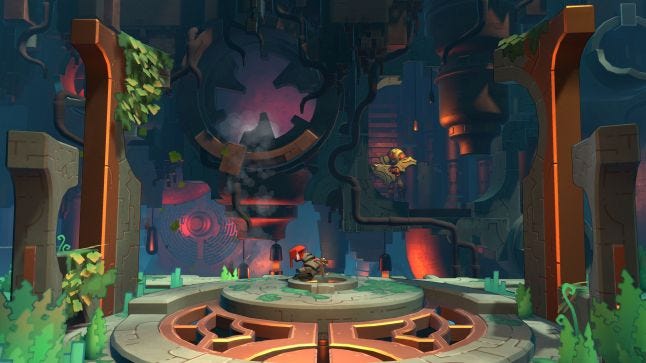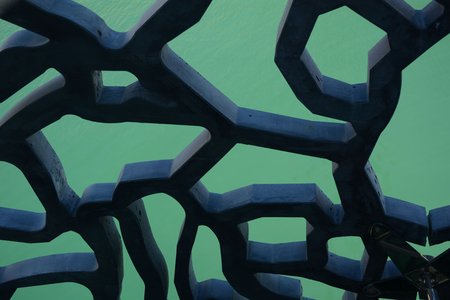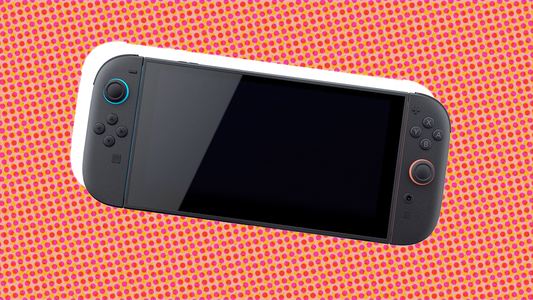Hob is an action-adventure title in the vein of Zelda: A Link to the Past. This latest release from Runic Games (Torchlight) encourages you to solve environmental puzzles with subtle lighting cues and camera direction, while gradually feeding you bits of narrative that pull you in deeper.
Gamasutra had the pleasure of talking to Runic's Patrick Blank, game director and lead level designer of Hob, about the well-received game in a recent Twitch stream. We've transcribed some of the more interesting passages of the conversation.
You can watch the stream embedded above, or click here to see it. And for more developer insights, editor roundtables and gameplay commentary, be sure to follow the Gamasutra Twitch channel.
STREAM PARTICIPANTS:
Patrick Blank, game director and lead level designer of Hob, at Runic
Wonder Russell, marketing manager at Runic
Bryant Francis, contributing editor at Gamasutra
Alex Wawro, editor at Gamasutra

World-shifting design
Gamasutra: World shifting is a core selling point of the game, the idea that the world will change and shift in major ways based on your actions. As one of the chief architects of this world, how did you build it? What are the practical challenges of building a game that can be entirely reconfigured? It sounds almost like you have to think through what it is intended to be, then work backwards from there, to change the world so that it can be put back into place by the player. Is that on point or no?
"On Torchlight II, the art had to be modular so we could quickly build things. And that carried over with our artists when we started Hob. We wanted the world to be a huge factor. We came up with several different ways that we could do shifting and rotations. We knew we'd have all these puzzle pieces that needed to fit together so that we could do this."
Patrick Blank: Yeah, it is. A lot of it comes down to just the tools you have, specifically the way the art was built, we were really smart, because coming off Torchlight II the art had to be a certain way, to be modular so we could quickly build things. And that's kind of carried over with our artists when we started Hob, we knew we had to have all these puzzle pieces, everything needed to fit together so that we could do this.
But we were talking about how we want the world to be different, we want the world to be a huge factor, how are we going to do this? We came up with several different ways that we could do shifting, and puzzle pieces and rotations and stuff like that, and we wanted to go for more of the bigger moments, try to sell that. And those are difficult to do.
Another goal is, always make the player feel small. You want the world to feel huge. Figuring out where we can do that and where those fit into the world... there are certainly some levels that are showcases, because they're rather large, but you don't want that to be a thing throughout, so you have smaller ones, and making those fit in with particular puzzles, or sections that you complete so that it feels like a satisfying finish to an area. Those are usually something that we identify early on in the level that we are making, and so we'll build everything around it to support and showcase it.
With the pieces we have, it's pretty easy to lay out, but it comes in the details later, of selling it, with the timing, the particles and the deco, and the other things that are going off around it. It's been a thing that we've been evolving as we've been going through development, to try to figure out better and easier ways to do it, and how it could fit into the game. It's something that people really live seeing, and it's one of the more satisfying elements of the game, when you finish something that transforms.

Gamasutra: What it reminds me of is, there's a level in Dishonored II called Clockwork Mansion. It's a level that changes shape and it's very striking. This entire game works in that fashion. When we talked to the designers of that game, they mentioned designing the level so that it makes physical sense. There's no trickery, like if a beam slides in and out it's actually rendered at all times, in or out, it never disappears into nothingness or clips into anything. Were you interested in achieving that level of weird physical fidelity in the game, even though the player doesn't often see it, or did you have to use some level design tricks to get everything to connect just right?
"We didn't want to take control away too much, or cut to a different camera and make it feel like it's not happening right in front of you. We don't really do cutscenes. That was a big goal of ours. When you see an entire zone rise up in front of you, you can walk on it. That's all real. It was a goal from the beginning to be able to do that."
Blank: A little bit of both. We definitely wanted everything to feel rounded, and as real in this game, as possible. So the elements do fit together really well, because of the way the art is made.
That Dishonored level is nuts. It's gorgeous! It's awe-inspiring what they did with that level. They're going beyond just one transformation, they're doing all sorts of really neat stuff. We definitely wanted ours to feel grounded within the world. It's a bit of having really solid art, and tools to do that with.
There is some trickery here and there where we really want it to happen, but we wanted to happen in real time, in front of the player. We don't really do cutscenes when any of that happens. A lot of them, people don't realize, you can run around on them when they're happening. To most people it feels like a cutscene so they just stand still to watch it, but you can run around on those large things while they're shifting.
We didn't want to take control away too much, or cut to a different camera, and make it feel like it's not happening right in front of you. That was a pretty big goal of ours. When you see the forest area, when you see an entire zone rise up in front of you and then you can walk on it, that's all real. And it was a goal from the beginning, to be able to do that.

Making top-down games look good
Gamasutra: I once heard a game critic say about top-down games that there was a problem with them, that you spent so much time staring at the ground. Like we are here (in the stream) following Hob on his adventure, and sometimes the camera takes us to the right place, but this critic says for games like strategy games, for games like Diablo or whatever, they said that essentially you're staring at hard rock. So what do you think about that, how do you make staring at rock interesting and make it narrative-rewarding?
Blank: We have some experience with that for the first two Torchlight games. I think in Torchlight 2 we started to do it, not with the player traversing vertically, but hinting at it with drop-offs and depth in the dungeons. And, again, a bit goal with Hob from early on was I wanted the player to feel small, so that the world feels huge.
"We do have a lot of verticality in Hob. We do certain camera pull-outs and pans to show you certain things as well, and we've spread out enough vista points throughout, so it doesn't feel like you're always looking at the ground."
Like what you're doing right now in the game while we're streaming, you can see down off the current ledge. We do have a lot of verticality in Hob, because myself and level designer Rick Lesley, we wanted to play with that as level designers, especially with the different types of navigation that we have. Because of that, the levels naturally build out this depth that breaks up the ground, so you're not always staring at the ground.
We do certain camera pull-outs and pans to show you certain things as well, and with our vista points, we've spread out throughout the game enough points that we're changing to shifting things to show you that, so it doesn't feel like you're always looking at the ground. In combination with a lot of the depth we're doing in the levels, especially outside there's cliffs, not only to show you decoration out there but to show you parts of the world you'll get to later, so we're hinting at that. S
No tags.



































